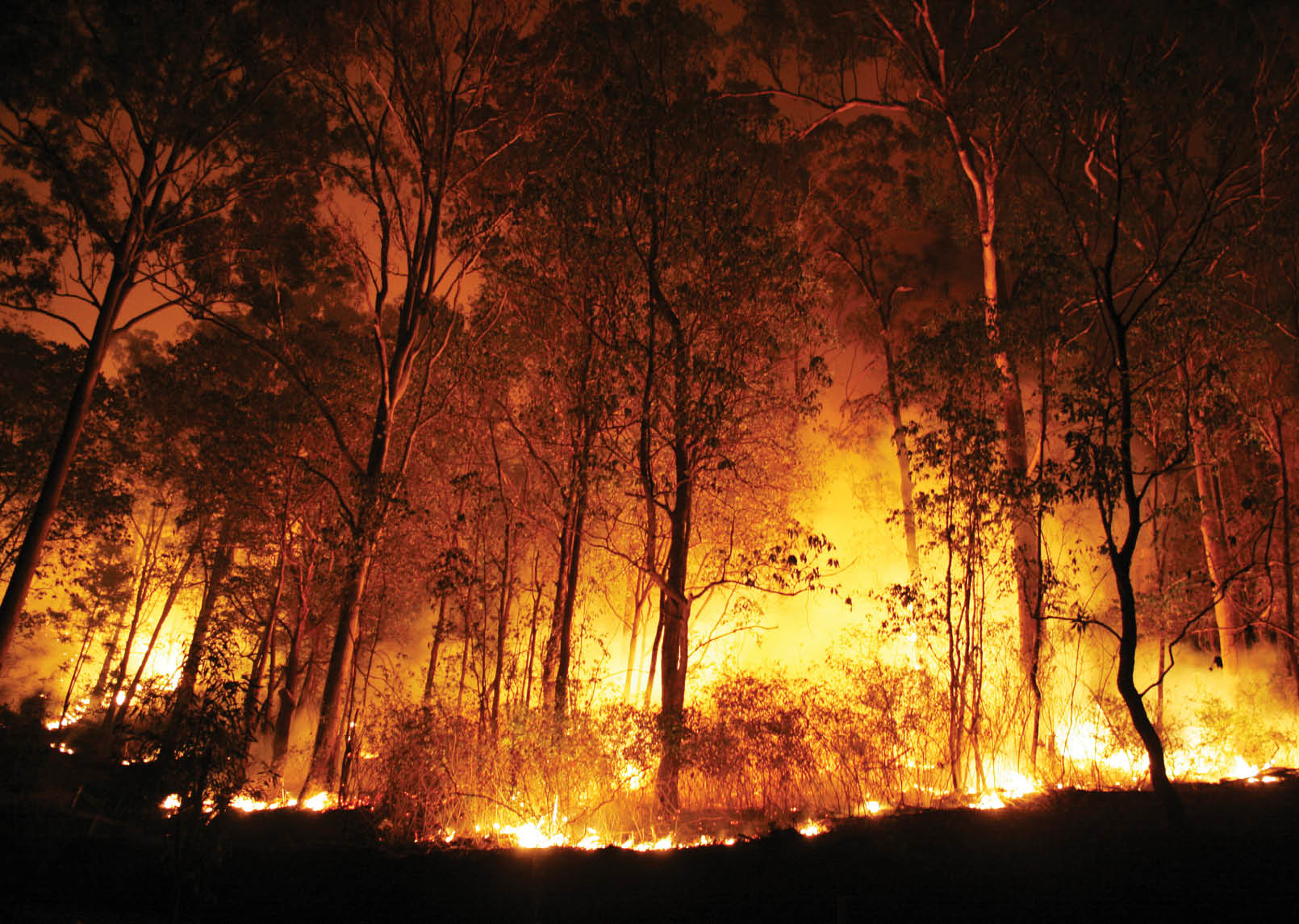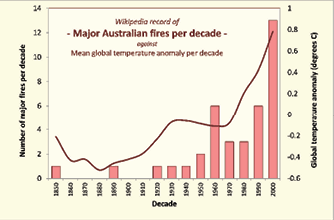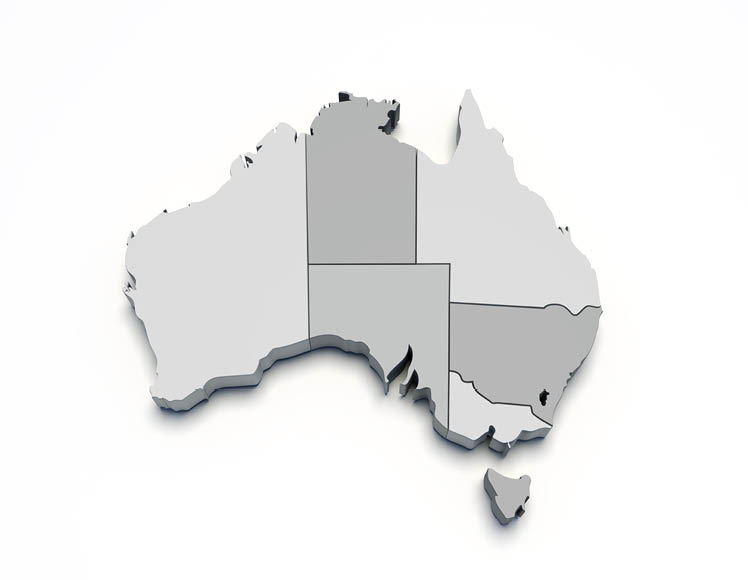





A bushfire is the stuff of nightmares. I doubt I could imagine anything more terrifying than having a bush-fire bearing down on me on a hot and windy day. On such a day the fire front can throw hot embers many kilometres, starting new fires and causing the main fire to spread rapidly. The radiant heat from a fire like this would be so intense that even 100 metres away it can cause serious burns to your skin. There is no jumping in a creek or wombat hole to avoid this fire. The only way to be ensuring your survival is to be somewhere else. And then, on a day only halfway up the Fire Dan-ger Rating scale, it can get very ugly out there.
A large bushfire releases so much energy that it can create it’s own weather system. Fires can create wind, clouds and even tornadoes (a pyro-tornadogen-esis event) - like the one that destroyed homes and lives in Canberra.
Historically, Australia received occasional very bad bushfire seasons. In the past few decades we have seen more intense, fast moving and devastating bush-fires than we imagined possible. It now seems that this is a pattern set to continue and get worse. Last year the IPCC (Intergovernmental Panel on Climate Change)predicted that “in south-eastern Australia, the frequency of days when extreme fire danger threatens will increase by up to 25 per cent by 2020, and up to 70 per cent by 2050.”
As bushwalkers we love to get out and explore. It is very hard to call off a walk because of a potential risk - especially when there is no actual fire. This year we have been reminded that devastating fires can sneak up on communities. In Spring (October 2013) we saw around 200 homes destroyed and large areas of the Blue Mountains burnt. We need to be particular-ly mindful of bushfire risk in spring, summer and early autumn.
So how do we make the decision to go or not go on a walk considering the bushfire risk?
Each state has their own agency responsible for bushfire around Australia. In the past few years a consistent approach fire danger rating has been ad-opted across the country. In NSW the RFS is the lead agency on bushfires. So, by way of a starting point the RFS say that “Severe, Extreme and Catastrophic Fire Danger Ratings mean a fire will be unpredictable, uncontrollable and very fast moving. This means that you may have little or no warning about the threat of a bush fire.” They also say for these days that “Leav-ing early is the safest option for your survival”. The RFS also say that “a Total Fire Ban is declared for days when fires are likely to escape and be difficult to contain. This is caused by a combination of dry vege-tation and hot, dry, windy weather.” It would seem the context of their advice is for people living or working in Bushfire prone areas; how much more should we heed this advice in a nylon tent?
What is a Bushfire danger rating? It is a forecast of a potential fires behaviour, the difficulty of suppress-ing a fire, and the potential impact on the community should a bush fire occur on a particular day. The rating ranges from low-moderate for days where fires are likely to be slow moving and easy to control - to Catastrophic for those days where a fire will be un-believably hot, fast-moving and uncontrollable (think Canberra 2003 and Victoria 2009).
What is a Total Fire Ban day? It is a day where open fires are banned by the RFS Commissioner. The ban is put in place to limit the number of fires that esc-ape and threaten life, property and the environment, especially on days when it is very hot, dry and windy. This means that it is illegal to use portable camping stove on a bushwalk, including inside a tent.
“The number of major fires per decade record-ed on the Wikipedia… The line shows the global temperature anomaly, and the arrow marks the point when scientists first began warning that excessive fossil fuel use would warm the globe.” Philip Zylstra

BWA December 2013 | 23
Fire danger ratings and Total Fire bans are usually announced at about 5 pm the day before they come into effect. Some park managers will close track and trails during total fire bans. Park managers may not get closure information on their website for several hours after the announcement, if at all. Bushwalkers need to be proactive about our safety and chase the information when we need to make a decision, not leaving it up to chance.
It is safest to first assume you will cancel you walk on days of total fire ban as well as on severe, extreme or catastrophic fire danger rating. If you think it still safe to continue then chat with the park manager to see what they say, they may also think that the specif-ic conditions means that the planned walk is still safe to go ahead. Fire Danger Rating regions cover a large area, therefore due to local conditions some sections may have a lower risk then the whole region - but it is important that we seek advice from the park managers who have a broader knowledge of the conditions, fuel loads and other activities in the park.
On days of Extreme or Catastrophic Fire Danger Ratings the weather conditions will be uncomfortable and the risk from fire will be very significant. I would recommend you postpone your walk even if the park remains open - it is just not worth the risk.
On longer multiday trips this obviously becomes more challenging. Carry non-cook meals and wa-
ter purification systems that do not require a stove. Always register your walking plan with local Police or NPWS office. If there is a significant risk of fire during your walk and it is possible to leave the walk early, then this is the safest option. If leaving bushfire-prone area is not possible then ensure you consider the safest areas for retreat and possible shelter from ra-diant heat. Stay alert to weather conditions and keep an eye out for any sign of fire. Check the local fire website if in mobile phone range or monitor local ABC radio stations for emergency broadcasts.
Phone for help or use your PLB if there is a threat of grave and imminent danger. Do not presume that rescue can make it in time. Rescue is challenging in high winds and when resources are stretched.
If you are in doubt play it safe: there are another 51 weekends in the year. Equally, don’t let this scare you off - pick the days and have alternative activities planned during fire seasons. Wild places by their nature present risks, lets take them seriously but still enjoy these amazing places at the right times.
Matt McClelland
This article is adapted from an article Matt wrote for the NSW National Parks Association journal ‘Nature NSW’ December 2013.


























LOW-MODERATE
HIGH
VERY HIGH
SEVERE
EXTREME
CATASTROPHIC (CODE RED)
TOTAL FIRE BAN

24 | BWA December 2013


Helpful links
Please check weather, park closure, fire bans and fire danger rating before setting off for your walk. Each state and territory has differ-ent rules for what is allowed on a total fire ban. Please check your state fire agency and parks manag-er for local information.
Weather forecasts - Australia wide http://www.bom.gov.au/
pfes.nt.gov.au
parksandwild-life.nt.gov.au
dfes.wa.gov.au
dec.wa.gov.au/
cfs.sa.gov.au
environment.sa.gov.au
environment.nsw.gov.au rfs.nsw.gov.au
Victoria
cfa.vic.gov.au
parkweb.vic.gov.au
ACT
esa.act.gov.au
tams.act.gov.au/
Tasmania
fire.tas.gov.au
parks.tas.gov.au





















BWA December 2013 | 25
FIRE DANGER RATING table
FDR
Likely Fire Behaviour
Impact Potential
Your Action
• Fires will be uncontrollable, unpredictable and very fast moving. Highly aggressive flames extending high above trees and buildings.• Thousands of embers will be violently blown around starting more fires up to 20 km ahead of the main fire.
• Fire can threaten suddenly, without warning and be incredi-bly hot and windy making it diffi-cult to see, hear and breathe as the fire approaches.• People in the path of the fire will almost certainly die, or be injured and significant numbers of homes and businesses destroyed or damaged.
• Ensure that your survival is the primary consideration in any decision.• The safest option is for you and your family to leave early, hours or the day before a fire occurs.• Under no circumstances will it be safe to Stay and Defend.• Ensure you stay well informed of current fire activity by monitoring local media and regularly checking for updates onthe RFS website or Information Line.
EXTREME
• Fires will likely be uncon-trollable, unpredictable and fast moving with flames in the tree tops, and higher than roof tops.• Thousands of embers will be blown around and into homes causing other fires to start and spread quickly up to 6 km ahead of the main fire.
• Fire can threaten suddenly, without warning and it will be very hot and windy making it difficult to see, hear and breathe as the fire approaches.• There is a likelihood that people in the path of the fire will die, or be injured and many homes and businesses destroyed or damaged.
• Ensure that your survival is the primary consideration in any decision.• Leaving early (hours before) will always be the safest option for you and your family• If your Bush Fire Survival Plan includes the decision to Stay and Defend, only do so if your home is well prepared, specifically designed and constructed for bush fire and you are currently capable of actively defending it.• Stay well informed of current fire activity by monitoring local media and regularly checking for updates on the RFS website or Information Line.
SEVERE
• Fires will likely be uncon-trollable and fast moving with flames that may be higher than roof tops.• Expect embers to be blown around and into homes causing other fires to start and spread up to 4 km ahead of the main fire.
• Fire can threaten suddenly, without warning and be very hot and windy which will make it increasingly difficult to see, hear and breathe as the fire approaches.• There is a chance lives may to be lost and people injured and expect that some homes and businesses will be destroyed or damaged.
• Ensure that your survival is the primary consideration in any decision.• Leaving early (hours before) is the safest option for you and your family.• Follow your Bush Fire Survival Plan.• If your Bush Fire Survival Plan includes the decision to Stay and Defend, only do so if your home is well prepared, and you are currently capable of actively defending it.• Stay informed of current fi re activity by monitoring local media and regularly checking for updates on the RFS web-site or Information Line.
VERY HIGH
• Fires can be difficult to control and present a very real threat.• Embers may be blown around homes causing other fires to occur up to 2 km ahead of the main fire.
• Fire can threaten suddenly, without warning and it may be hot and windy and it may be-come difficult to see, hear and breathe as the fire approaches.• Loss of life or injury is unlikely though some homes and businesses may be damaged or destroyed.
• Ensure that your survival is the primary consideration in any decision.• Be prepared to implement your Bush Fire Survival Plan.• Stay informed of current fire activity by monitoring local me-dia and regularly checking for updates on the RFS website or Information Line.
HIGH
• Fires can be controlled but still present a threat.• Embers may be blown ahead of the fire and around homes causing other fires to occur close to the main fire.
• Fire may threaten suddenly and without warning.• Loss of life is highly unlikely and damage to homes and businesses limited.
• Ensure your family, home and property is well prepared for the risk of bush fire.• Review and practice your Bush Fire Survival Plan.• Monitor local media for fi re activity and regularly check the RFS website or Information Line.
LOW-MODERATE
• Fires can be easily con-trolled but can still present a threat.
• Little or no risk to life or homes.
• Ensure your family, home and property is well prepared for the risk of bush fire.• Review and practise your Bush Fire Survival Plan.• Refer to the RFS website or Information Line for changes in fire activity.
For more information check
http://www.rfs.nsw.gov.au/file_system/attachments/Attachment_FireDangerRating.pdf

















CATASTROPHIC
26 | BWA December 2013